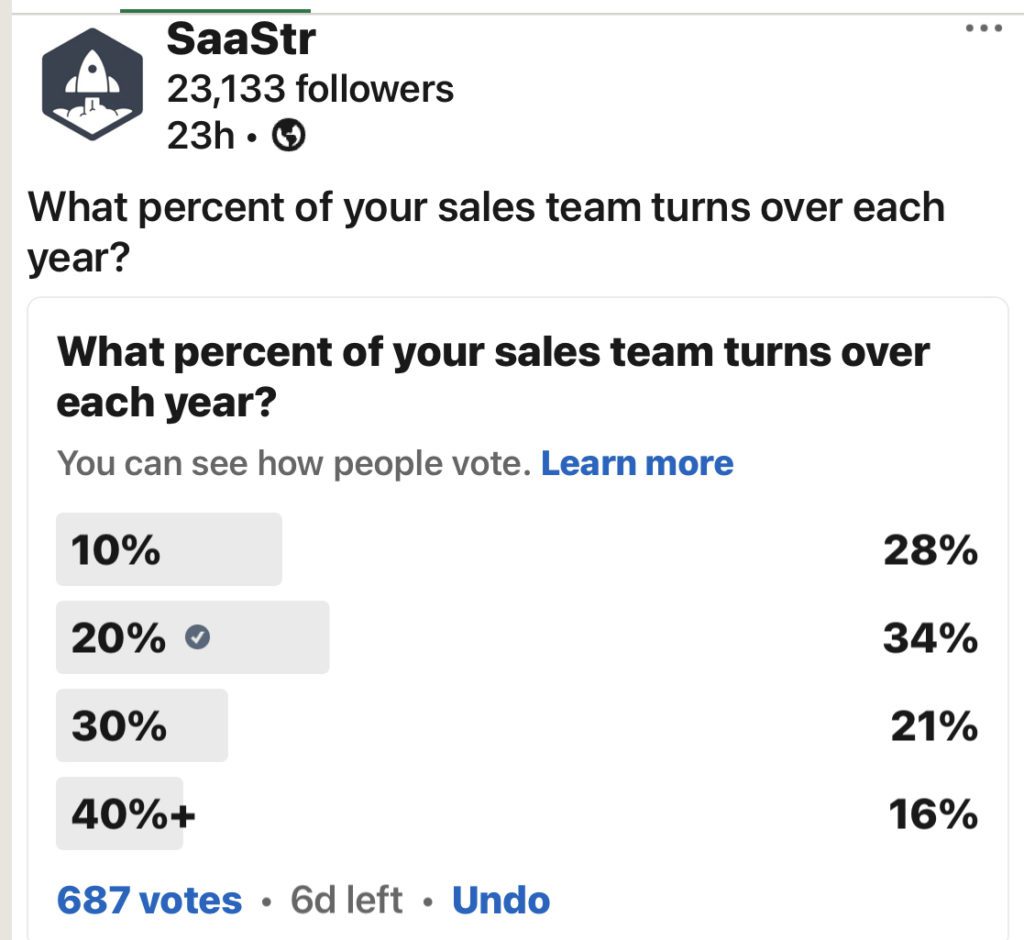There’s a common thinking that sales teams should be relatively high churn. That they almost sort of have to be. That the bottom 15-20% of the sales team almost has to churn each year, because it’s survival of the fittest. Reps have to fight for the best leads, prove the highest close rates, exceed the mean of the bell curve, to not just thrive, but survive.
Maybe this is true if you are a mortgage broker. Selling a completely fungible product. Maybe. I’m not sure.
And it clearly is true, in part, at SaaS companies beyond $200m in ARR. At most SaaS companies, the bottom end of the sales team churns out each year. They’re often managed out, not fired, but same thing. And these days, more and more folks are willing to move to another SaaS startup promising a 10%-20% higher OTE.
But for many SaaS start-ups, I think accepting this is not only a huge mistake, it’s a recipe for tragic underperformance.
Let’s step back for a minute.
First, do sales reps really compete with each other? Usually – no. Not directly. At least, not for a while. They are routed leads. By round-robin, by territory, by whatever. And for a long time, leads are precious. You want the maximum revenue per lead. So you really want every single sales rep to kill it. Each one consumes X% of your leads. If one can drive a Tesla Models S Performance — in theory, at least, given the same number and quality of leads — they can all drive one. More on this here.
 Second, at least for a long time, sales reps are a revenue center, not a cost center. If you try to align leads with reps, and you pay the reps, say 20% all-in of the revenue they bring in … reps are a revenue and profit center. More on this here. Not a place to save money.
Second, at least for a long time, sales reps are a revenue center, not a cost center. If you try to align leads with reps, and you pay the reps, say 20% all-in of the revenue they bring in … reps are a revenue and profit center. More on this here. Not a place to save money.
Third, trained, scaled reps are extremely valuable. It costs a lot to train a rep in indirect costs. They squander a lot of leads in the early days. They suck up a lot of management time. They answer questions all wrong for a while. The less of this, the better. You make more money per lead, with less work per lead.
Fourth, the best sales teams stick together. If a rep is making a killing, and knows her product cold, and has a great boss — they never leave. Unless it’s for a management role they can’t get. For individual contributors, you see very little voluntary attrition other than promotion in the best run sales orgs. And they feed on each other, challenge each other, help each out, go out for raw steaks together.
Fifth, the very best sales team attract more reps like flies to honey or moths to light. There are just soooo many start-ups. So many. If you’re a sales rep — how do you pick? You want three things: (x) a great boss, (y) ability to make serious coin, and (z) a winning product. Add excessive churn to this environment, and at least, (y) becomes a concern. Why go to a boiler room, when down the street on Market, I can make just as much money at 20 other start-ups?
So it turns out, just like engineers, you don’t ever want to lose any great sales reps. Any of them. And if you recruit right — why can’t the vast majority make it? They can.
Let me challenge you further. Try to build a Zero Voluntary Attrition Sales team. No one is allowed to leave. 🙂
Ok. So how do you create this beast? The key is — you have to do it all:
- You have to pay (high) market. You can’t be cheap. You have to pay market, and later, high market. But this doesn’t have to bankrupt you as long as it scales with revenue closed. See our Initial Sales Comp plan here.
- You have to find as many internal promotion paths as you can. Otherwise, you won’t lose individual contributors, but you’ll lose those gunning for management. You have to find a way to promote SDRs to AEs. And at least some AEs to team leads. This works out OK if you are growing quickly, it’s harder if you aren’t, but you have to find a way. A great hack here is to make it crystal clear to top ICs that they will make less money as manager. That will limit the wanna-bes that like the idea of a bigger title but aren’t willing to sacrifice short-term comp. If nothing else, fill at least half of your manager slots from internal promotions. Let everyone know 50% of management roles will come from within. That way everyone knows they have a shot. More here:
- You have to invest more in onboarding and internal training. Any rep should be scaled up in 30 days. If you train and onboard them right. Otherwise, you’ll see too much churn from reps that don’t make it without enough training and onboarding … but could have killed it with more help in the first 30 days. There are many, many great reps that just need help getting going. They don’t just intuit it on their own. Help them. Train them. Make it a core competence, a center of excellence.
- You have to constantly work to stamp out any sexism, and other -isms. Bro Culture puts this goal at high risk. If you allow a Bro Culture to permeate your sales team, you’ll eventually lose folks that don’t want to be in that environment, and you’ll cut off a large pool of potential candidates. Quietly pull aside anyone who makes inappropriate remarks and just tell them that’s not us and you never want to hear it again. Make it a core cultural value to hire as diverse a sales team as you can.
- You have to have quotas that 80% of the reps can achieve. Yes, make it hard. Yes, make it a stretch. But if 80%+ of your reps are great … 80% of them should be able to achieve quota. Having a minority of reps hit quota helps no one. More on that here:
- You have to make reps feel like their territories and leads won’t be stolen from them. This is a nuanced issue to work on with your VP of Sales, later. But as you scale, many traditional VPs of Sales will want to constantly shrink territories, reduce the number of leads per rep, or worse … shift your best reps to the worst territories. There’s an art here, and some of it you do have to do. But take it too far, and make it seem greedy, or unfair — and the great ones won’t stay. That’s a raw deal to a rep that’s killing it. She’s investing her life and long-term economic future in your start-up. It’s a Sales TEAM, friends.
- You have to have everyone in the interview process agree each rep is at least as good as the average current rep. You have to do this and enforce it. You can’t let the bar go down just because you are behind in hiring. If you do, you’ll sneak back into a high churn environment. And a rapid, downward spiral in sales attainment.
- You have to make Zero Voluntary Attrition a core company value. We are a Zero Voluntary Attrition organization. If anyone great leaves — that’s a failure. For you, as CEO. For us, as a team. We should be able to spot failure before it starts. We know how to do this.
- You have to spend more time as a founder with the sales team — so you can help identify the folks that are close to leaving. Ambitious people will often be close to leaving even at the best organizations. Then, find a way to keep them. A few more options. A clear path to a promotion. A Thank You. Find a way. More on how to keep folks that are almost out the door here. And ask every top sales rep what they want. A new perk, a new bonus plan, what would make them happiest. Try to deliver at least one bit of new, additional happiness to every top-performing sales rep if you can.
A lot of these ideas apply across the entire company, really, in every function.
It’s just only in Sales do groupthink and traditional enterprise sales procedures seem to sometimes expect high-ish churn.
Don’t accept it. At least, not before $40m-$50m ARR. Every lead, every extra dollar of revenue, every chance to grow 10-20% faster than otherwise is precious. And a truly great sales team can just take you so, so much further than a merely good one.
This is what the Second Timers really know.
(note: an updated version of a SaaStr Classic post)
There's always a 50% chance that manager you need to hire already works for you
Double check that your top ICs aren't ready
— Jason ✨BeKind✨ Lemkin #ДобісаПутіна (@jasonlk) February 10, 2022


